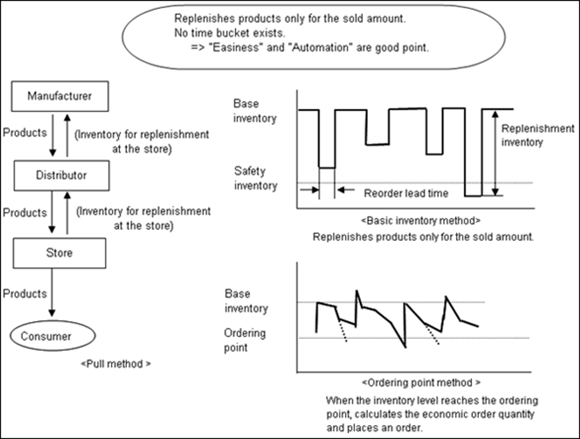CRP (Continuous Replenishment Program)
2008.05.13
Method of replenishing products in real time as needed only for the sold amount. "CRP" is a concept that supports the ECR strategy that was figured out for supply chain management of processed foods.
"CRP (Continuous Replenishment Program)" is a base that supports the Efficient Consumer Response (ECR) strategy, which is famous for Supply Chain Management (SCM) of processed foods. Unlike Material Requirements Planning (MRP) and DRP, time buckets for creating a schedule for certain time periods do not exist. In other words, as a basic rule, products are replenished only for the sold amount as needed in real time, and there is no specific order point or expression for calculating the order batch size. CRP is also referred to as a water supply method in the way that water will be supplied from a tank when needed and for the amount you need if you turn on a faucet.
When CRP is conducted in a retail store such as a supermarket, orders will be placed from the store corresponding to the POS data at cash registers. However, for data processing timing and economic efficiency reasons, it seems that complete CRP is not actually performed at retail stores but a method focusing on speed and cost of goods flow is designed. For example, CRP is used combined with the ordering point method in which an economic amount of orders will be calculated for order placement when the inventory level reaches the ordering point or with the replenishment ordering system that aims to return the inventory level to the basic inventory.
Conceptually, if a supply chain is linked to the system that replenishes the inventory in refrigerators of consumers, the method is perfect as CRP and throughput will surely increase. From the viewpoint of a processed food manufacturer, since consumers buy replacement foods when the inventory in their refrigerators reduced, the manufacturer will have an opportunity loss if the inventory in refrigerators of consumers is not included in their supply chain.
Synchronization of a supply chain will differ depending on whether expansion of throughput of supply chain management is intended to be done focusing on particular products or product categories. From the point of product categories of a manufacturer, synchronization of production and distribution will be important. On the other hand, from the point of a pull strategy to consumers using advertisement, synchronization of sales force will be important. There will be a large difference in throughput how much product shelve expansion and advertisement/promotion can be synchronized or how much production and distribution can be synchronized.

Taken with kind permission from the book:
"Understand Supply Chain Management through 100 words" by Zenjiro Imaoka.
Published by KOUGYOUCHOUSAKAI
